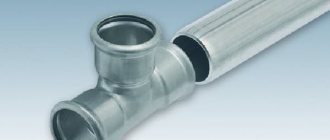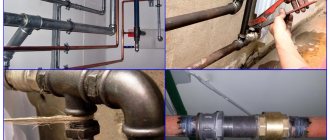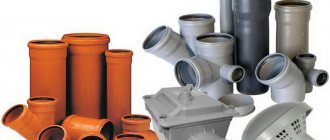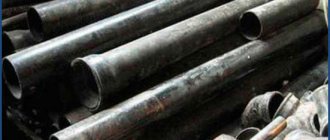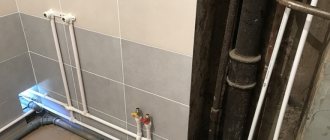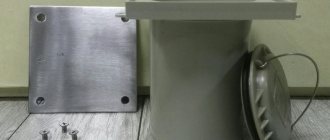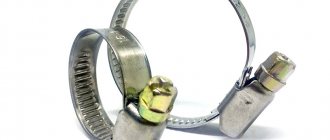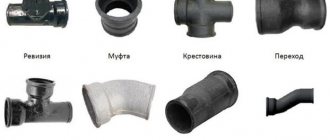It is important that after installation there is no leakage. The joints must remain dry. If the connection zone is installed incorrectly, blockages may occur, which requires dismantling and reinstalling the system.
That is why the question of how to combine sewer plastic pipes with each other is always relevant and requires detailed consideration.
Material orientation
When starting serious work - choosing an option for joining sewer pipes, it is important to find out in advance what material you will have to deal with.
Today the following products are used in drainage systems:
- made of PVC (polymer);
- cast iron;
- become;
- concrete;
- ceramics;
- asbestos cement;
- corrugations.
The first two types of material are most often used, while the others are quite rare. Corrugated pipes are in demand in external pipelines of private buildings or as components of networks of large production facilities.
Cast iron pipes are used in external drainage systems. Compared to steel ones, they are quite heavy, so they are not suitable for internal sewerage, especially if they are installed by one person. But at the same time, cast iron pipes are not afraid of corrosion, like steel ones, and have a long service life, and are also in demand in heating systems, in particular, when installing risers. Although not every person will connect complex elements in cast iron pipes. The disadvantage of such products is the regular adhesion of waste inside the pipe due to the uneven surface. In winter, during the heating season, they are more susceptible to clogging. Compared to them, polymer products are more practical.
How to combine plastic with cast iron
It should be noted that a complete replacement of cast iron products has not yet occurred. The complexity of installing such a sewer system is quite high. In this case, it is necessary to combine products made from different materials. This work is carried out using developed technology.
Docking with socket
When the condition of the cast iron product does not cause any concern, and the surface of the socket has retained its smoothness, you can use a special sealant for joining. The work is performed in a certain sequence:
- The surface is cleaned of rust and all dirt is removed.
- Sealant is applied to the outer surface.
- A rubber adapter is inserted into the socket.
- The new cylindrical product is mounted into the cuff.
This technique is considered the simplest. It allows you to begin operating the sewerage system immediately after its assembly. In addition, to perform such work you do not need to resort to the services of professionals.
Docking without socket
When a cast iron product does not have a funnel-shaped expansion, another connection technology is used:
- A grinder is used to cut a small piece of pipe made of cast iron. This way the ends of the part are aligned.
- A special sealant is applied to the edges.
- An adapter well lubricated with a polymer composition is put on top.
- A plastic pipe is inserted into the connection. The tightness of such a docking unit always remains quite high.
Use of silicone and linen
This connection option involves the use of linen winding. To do this, you need to perform a number of operations:
- Where plastic is combined with cast iron, the PVC pipe is treated with sanitary winding.
- Cylindrical products are connected to each other. The remains of the thread with any sharp object, for example a screwdriver, are pushed into the resulting gap.
- The docking area must be covered with a polymer-cement mortar consisting of cement, PVA glue and water.
When the work is completed, you need to wait one day and only then begin operating the sewer system.
Another option for connecting cast iron and PVC involves the use of plumbing silicone. This technique shows a positive result if there is a small gap in the joint, approximately 2 mm.
The products are pre-dried well. To do this, you can use a hair dryer. The narrow gap is filled with plumbing silicone using a special gun. The strength of the connection depends on the depth of penetration of the composition: the deeper it is, the better.
The silicone dries after 5 hours, and only after that can you begin to operate the drainage system.
Plastic pipes: advantageous connection
Recently, products made from polyvinyl chloride are at the peak of popularity, displacing metal analogues, which in their technical parameters are significantly inferior to plastic ones. The main feature of plastic pipes is softening at elevated temperatures and returning to their original state at low temperatures (read: “Options for connecting sewer plastic pipes - advantages and disadvantages of methods”).
To understand how to connect plastic sewer pipes, you need to consider the positive arguments in their favor:
- anti-corrosion properties, thanks to which PVC products can be safely laid underground without additional insulation and at the same time save significantly;
- chemical resistance to substances and aggressive environments;
- low weight of plastic pipes;
- excellent throughput due to the smooth internal surface;
- service life, which can reach 100 years;
- easy installation that allows you to build any type of drainage system.
The downside to using PVC pipes is limited throughput. Although this drawback can be completely resolved if you choose a larger pipe. Knowing the diameter and length of the product, it is easy to select parts for the plastic sewer network. Knowing theoretically how to connect two pipes of different diameters, you can begin practical actions.
This type of pipe is also successfully used for external sewer networks. At the same time, in bitter frosts, you need to pay attention to thermal insulation, for example, purchasing soft insulation.
What are plastic pipes
This is a generalized concept that contains polymer pipes consisting of the following components:
- polyvinyl chloride,
- polyethylene,
- polybutylene,
- polypropylene.
The main property of these materials is their ability to become soft when heated to high temperatures, and then, when cooled, to recreate their configuration and functionality.
When laying sewer systems, many people prefer plastic pipes.
Metal products are used much less often.
The undeniable advantage of a plastic pipeline:
- It is not subject to corrosion process. When laying pipes in the ground, no insulation work is required.
- Not susceptible to the harmful effects of chemical substances and environments that have a destructive effect.
- Moderate weight.
- High throughput of the design, which is achieved thanks to the smooth surface from the inside of the product.
- Easy to install . By using fittings, you can create a pipeline of various configurations.
- Resistance to mechanical impacts.
- Impeccable flexibility of the material.
- Long service life and safe operation of the system for many years.
What do you know about deep well pumps? Their operating conditions, types and scope of application are described in a useful article.
Read about an electric hot water boiler here.
On the page: https://ru-canalizator.com/santehnika/oborudovanie-santehnika/bassejn.html read about a children's outdoor plastic pool for a summer residence.
With all the above advantages, plastic has some disadvantages:
- thermoplastic materials are afraid of high temperatures and they have strict limits on permissible operating pressure.
Joining of PVC pipes for sewerage, fittings
Often at home, plastic pipes are joined together using fittings. These are a kind of connectors that ensure the tightness of the structure, eliminating the penetration of dampness and unpleasant odors from the system. Thanks to the wide range of these products, repair work is facilitated and worn-out elements are replaced with new ones.
Let's look at how to connect sewer pipes using fittings.
The latter are classified into types that differ in:
- functions (intermediate or connecting fittings);
- structures (couplings, tees, turn signals, extensions, etc.);
- shape (straight, T- and L-shaped).
Using this classification, you can easily select the appropriate pipe material and explain to the store which fitting models you are interested in.
When inserting the pipe into the fitting, do not forget to first butt the rubber gasket.
What should you consider during the planning process?
An event such as the correct insertion of plastic drainage pipes into a building requires compliance with certain rules, the most significant of which are:
- The thickness of the outlet pipe must be equal to or greater than the diameter of the riser, otherwise the efficiency of the system may be insufficient.
- Pipes (PVC - read the transcript) connecting the section of the sewer canal to the main network should be located on one side, provided that there are several such pipes.
- Connection to the main canal is carried out only through a well. Such an object should be located at a distance of no closer than 3 meters from residential buildings. This need is dictated by the fact that with such an arrangement, in the event of a blockage or rupture, the buildings will not be damaged.
Preliminary steps before connecting
How to connect sewer pipes that are components of a large system? The answer to this question involves several sequential actions.
First of all, you need:
- Prepare a drawing of the system. It is important to take into account the existing objects in the house or apartment to which it is planned to lay drainage pipes, for example, a shower room, a bathtub, a toilet.
- Determine where the pipes join the central riser, and this is where the fittings will be needed.
- Remember that pipes for private sector sewerage are classified into two types according to cross-sectional size: 110.50 mm. It is the latter option that will be the ideal solution for laying pipes for a shower stall, bathtub, sink, or washing machine.
Before purchasing drainage pipes, you need to calculate in advance the required footage of the material so as not to waste money on excess plastic. After all, these products cannot be damaged.
Among the connectors, the turning fitting is of great importance, designed for joining a siphon (a hose from a plumbing fixture) and a drainage pipe made of PVC or metal. Some specialists neglect this connecting element, and in vain. After all, its absence can break the tightness of the system, and the joint will constantly let water through.
In order to ensure the longevity of the functioning of the drainage system, it is necessary to note certain nuances:
- Provide a specific slope of the pipes, which is calculated taking into account the amount of reduction - no more than 2-3 cm/m of the product. This indicator is needed for rapid removal of liquid.
- When arranging the pipeline, start from the plumbing to the central riser so that in the future the joints do not interfere with the flow of liquid in the system.
Knowing how to connect sewer pipes at the initial stages, you can protect the system from possible leaks in advance.
The main subtleties of laying external sewerage
Fittings are used when arranging intra-house or intra-apartment sewerage. The situation is completely different with the external system, which is installed on the site near the house. In this case, it is necessary to start with the construction of wells intended for water purification.
Having understood how to join drainage pipes, it becomes clear that the external system requires products of larger diameter.
It is imperative to take into account the fact that the diameter of the outer pipe should be slightly larger than the size of the sewer pipe. It is better to take material with a “reserve” than to change the entire drainage system when there is a desire to connect new plumbing fixtures.
Having completed the preparatory steps, you can begin the serious business of connecting sewer pipes. According to the types and joints of pipes, two connection options are distinguished: detachable and permanent.
Joining of pipes using the detachable method
Such connections are classified into flange and coupling. For plastic pipes it is better to use the first option. To achieve excellent tightness, it is better to use cast iron fasteners and rubber gaskets in detachable connections.
Let's look at how to properly connect sewer pipes using flanges step by step:
- Cut the pipe very smoothly, without chamfers.
- Place the loose flange over the cut.
- Insert a spacer protruding 10 cm from the cut line.
- Place a flange on it and connect it to the mating fittings.
- Secure with bolts.
During repairs or installation of pressure/non-pressure systems, coupling connections are used.
For the system to function trouble-free, you need to:
- Before connecting the pipes to each other, cut off their ends at 90°.
- Attach the coupling to the joint so that it is located exactly in the middle of the connector.
- Make a mark on the pipes indicating the location of the coupling.
- Treat the ends of the pipes and the fitting from the inside with a special lubricant.
- Insert one of the pipes into the coupling until it stops.
- Join the pipes without distortion to form a single axis.
- Push the coupling onto the second pipe up to the previously made mark.
This detachable method is very convenient for disassembling the pipeline if necessary. When assembly is performed, great attention is paid to sealing the joint.
Using silicone sealant
Silicone-based sealant makes it possible to create an almost eternal connection between a polymer and cast iron pipe. But connecting with it has a number of nuances that must be taken into account:
- The junction of plastic and cast iron pipes must be absolutely dry. To achieve this, it is better to use a hair dryer;
- When filling the gap between the pipes with sealant, try to immerse it as deeply as possible. The strength and durability of the connection will depend on this;
- After completing the work, it is necessary to ensure that the sealant dries completely. To do this, it is not advisable to use the sewer for 5-6 hours.
One-piece types: nuances
Now let's figure out how to join sewer pipes using the one-piece method.
There are different methods, but here are the most common:
- "Into the bell" . According to the theory, a socket with a rubber ring is connected to the straight end of the pipe. Before starting work, all surfaces are cleaned and degreased, and the flat end of the pipe product must be chamfered. Before joining, both surfaces are treated with silicone grease, and if it is absent, with liquid soap or detergent, and then joined. In this case, the longitudinal axes of both products must coincide. The flat part is inserted into the socket no deeper than the previously made mark.
- Welding: socket or butt . According to the theory of the first option, using moderate pressure welding, the following are melted: the inner side of the socket of one pipe and the outer side of the smooth end of the other. If butt welding is done, then the ends of both pipes and the joint itself are melted. The latest technique allows you to understand how to connect pipes of the same diameter.
- Gluing . According to this method, the connecting ends are coated with a special glue. It is selected depending on the material of the pipes. For example, BF-2 is suitable for metal and plastic, epoxy adhesive is suitable for polymers and metal, grade 88N is suitable for rubber and metal.
Laying rules
Soft sewerage is installed in a similar way to traditional systems. However, in this case it does not require additional purchase of fittings for laying the route on turning sections. The product bends well, taking almost any shape.
When laying flexible sewerage, you must adhere to the following rules:
- The main line discharging domestic waste must have a slope, despite the ideal smoothness of the inner surface. Low hydraulic resistance does not require a large slope; it is enough to stick to 2 cm per 1 linear meter.
- Turning areas should be smooth. Bends less than 90 0 . This will inevitably lead to congestion.
- When laying a long straight section, the pipeline must not be allowed to sag. In this case, special holders are used.
- The connection of elastic pipe sections is carried out using a socket or a slip-on coupling. It is not recommended to use soldering at joints, as this reduces the strength of the sewer.
- The linear expansion of the flexible channel must be taken into account in order to reduce the risk of damage or deformation of the line.
- When arranging the external part of drainage from the sewer, the main characteristics of the elastic material are taken into account. This allows you to more accurately determine the maximum and minimum depth levels.
The most reliable connection option
The “into the bell” method is considered the most accessible and easiest type, which even an amateur can perform. But this option does not guarantee high tightness, because it is provided only by a rubber ring in the socket. The latter is inserted into the pipe product in the opposite direction relative to the direction of water movement.
The fittings are secured using O-rings. This method is applied to small diameter PVC pipes and allows you to understand how to connect two threaded pipes. Compared to metal models, there is no need for preliminary preparation for working with plastic.
The welding method requires additional knowledge and skills in operating the welding machine. But at the same time, this method is very reliable.
Excellent joint strength will be ensured by special glue. But before using it, it is necessary to clean the surfaces of dirt and thoroughly degrease them. Actions should be completed fairly quickly.
Our recommendations will help you understand such a difficult matter as joining sewer pipes. By making a high-quality connection, you will save yourself from unpleasant network leaks and breaks, frequent repairs and endless financial expenses.
How to join sewer pipes?
All communication installation methods available today are divided into two groups:
- detachable;
- one-piece.
In the first case, dismantling of the pipeline is possible. To connect sections of communications, couplings and flanges are used. Additional elements must match the size of the pipes. The outer diameter should be taken into account. The coupling is put on areas of products whose edges are cut at an angle of 90°. The center of this element must coincide with the line of communication junction. The flange mounting method uses bolted fastening.
Sewer pipes can also be connected using the one-piece method. In this case, the following options for installing pipeline sections are used:
- socket connection;
- welding, use special equipment (soldering iron for working with plastic);
- adhesive connection;
- installation of fittings.
The first option does not require the use of additional elements. When installing plastic products using this technology, only a rubber gasket is used. Additionally, the joint can be treated with silicone sealant.
If the welding method was chosen, in this case, using special equipment, the heated ends are pressed against each other. This option can be implemented by connecting products end-to-end and using an electric welded coupling. When heated to extreme temperatures, polyvinyl chloride loses its properties, softens, and becomes plastic.
If a connection is made at this moment, the end sections of the communications will be securely fixed, since they are soldered. When the pipeline cools, it will become solid. It will no longer be possible to dismantle it without damaging the pipe.
With glue
The method is based on the mutual penetration of the polymer at the molecular level. The adhesive connection of plastic sewer pipes requires the use of a special adhesive. When applied, it changes the structure of polyvinyl chloride, which allows you to reliably connect pipeline elements. Dismantling in this area will not be possible; communications will have to be cut. Installation instructions:
- The end areas are cleaned: burrs are removed and ground. In this case, the rule applies: the smoother the edges, the better the fit of the pipes to each other, which means you will get a fairly strong joint.
- To increase the reliability of the connection, the pipes are cleaned of contaminants. If dust or larger fractions remain on the surface, the quality of adhesion will deteriorate. As a result, leaks may appear after a certain period of operation.
- Prepared communications need to be degreased. In this case, the areas to which the adhesive will be applied are treated with a solvent.
- At the last stage, the products are connected. After applying the glue, the ends are pressed tightly against each other. After some time, the composition dries, silicone sealant is applied to the seam joint.
This technology is often used when installing sewer pipes using the socket method. It must be remembered that the adhesive used to install PVC communications contains volatile substances. After being applied to the surface of pipes, it quickly loses its properties, so it is necessary to install pipeline sections as quickly as possible. 1.5 minutes are allotted for this.
Using fittings
Purchasing special equipment (a soldering iron for connecting PVC products) is not always advisable, especially if internal installation of a pipeline is being carried out in an apartment or private house. The number of seams is small, which means you can use a simpler method - sewer fittings. Connecting elements are available in two types:
- cast;
- compression
There are a large number of designs that differ in configuration: cross, tee, bend, straight and transition coupling, revision. For connections using fittings, only a rubber seal is used. It is placed inside the socket. When the pipes are connected, polyvinyl chloride is treated with sealant along the seam.

